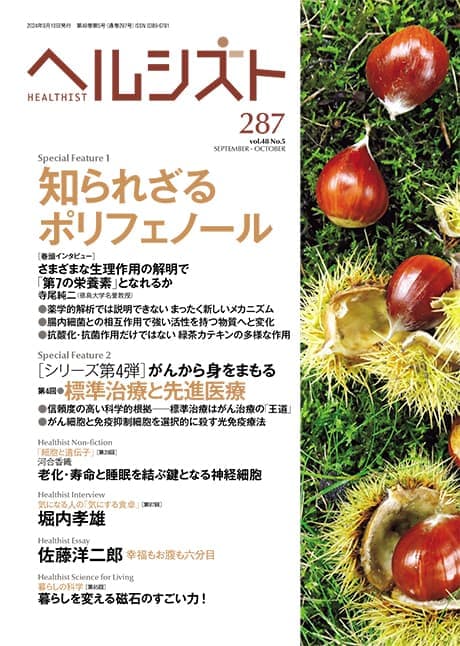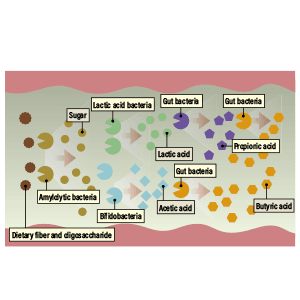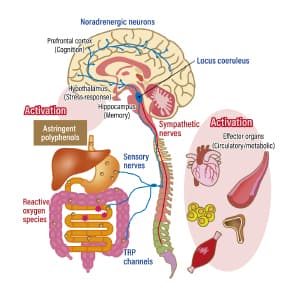Catechins are a type of polyphenol found in abundance in green tea and are also the principal component of its astringent taste. Green tea has been regarded as good for one’s health for centuries. Recent studies have scientifically demonstrated the powerful antioxidant, antimicrobial, and antiviral properties of catechins, and they have come to be used in a diverse array of medical treatments. Various other efficacies have also been reported, such as demonstrating anti-arteriosclerotic properties, improving lipid abnormalities, reducing visceral fat, and inhibiting rises in blood glucose levels and blood pressure. As such, they seem likely to be effective in preventing lifestyle diseases. One cannot help but say that green tea is a genuine superfood.
Special Feature 1 – The Mysteries of Polyphenols The diverse effects of green tea catechins go beyond antioxidant and antimicrobial properties
composition by Takeaki Kikuchi
A string of studies has found that catechins, the polyphenols found in green tea, have antimicrobial and antiviral properties. Green tea has long been regarded as being good for one’s health, so at Seirei Hamamatsu General Hospital, where I used to work, it was employed in a highly interesting therapy. Believe it or not, green tea was used to suppress the proliferation of methicillin-resistant Staphylococcus aureus (MRSA).
Green tea was administered to patients’ airways
MRSA is a pathogenic strain of the Staphylococcus aureus bacterium that has acquired resistance to various antimicrobial drugs. If it enters the body of an elderly person or other individual whose immune function is reduced, this bacterium renders them more prone to major life-threatening diseases such as pneumonia and sepsis. As it can also readily cause nosocomial (hospital-acquired) infections, it is a very tricky microbe to deal with.
Nurses at Seirei Hamamatsu General Hospital would combat MRSA by using a nebulizer to administer green tea into the airways of patients in whose sputum MRSA had been detected. A nebulizer is an inhalation device that turns fine particles into a mist to deliver drug solutions into the bronchi and lungs in order to treat asthma and bronchitis.
Based on empirical observation, the nurses evidently felt that the “tea nebulizer” was effective in reducing MRSA in sputum. However, as there was no scientific evidence for this, I conducted a clinical study to ascertain whether or not the tea nebulizer was actually effective. The study took place between February and July 1999, involving seven cerebrovascular accident patients (with an average age of 81) admitted to the hospital, in whom sputum tests had detected the presence of MRSA. Using a handheld nebulizer that they could operate themselves, the patients inhaled a mixture of 1 mL of normal saline in which catechins had been dissolved and 1 mL of an expectorant (bromhexine hydrochloride) three times per day for four weeks. Of the seven subjects, five were carriers of the bacterium and two were actually infected, but when tested four weeks after commencing inhalation, the measure was found to have been temporarily effective in three of the five carriers (but ineffective in the other two), while the two infected patients had shifted to carrier status.
After conducting a further pilot study, we carried out a multi-institutional randomized controlled trial to verify the anti-MRSA effect of catechin inhalation. A total of 69 patients (with an average age of 78) in whose sputum MRSA had been detected were randomly assigned between the catechin inhalation group (3.7 mg/mL catechins) and the control group (normal saline), and used a handheld nebulizer to inhale 2 mL of the solution three times per day. The reduction/disappearance rate based on the number of bacteria after a week of intervention was 15% in the control group versus 47% in the catechin group, which was a highly significant result. However, although a comparison of the numbers of patients in whom the bacterium had completely disappeared showed a higher tendency toward disappearance than in the control group, but did not reach the level of a significant difference.
A number of basic research reports that have emerged since then indicate that catechins are effective in preventing not only MRSA, but also viruses. These reports emerged from studies focused on the relationship of catechins to the influenza and other acute upper respiratory tract infections.
Habitual green tea consumption reduces influenza incidence
Between November 2008 and February 2009, we conducted a questionnaire among 2,663 students at all nine elementary schools in Kikugawa, Shizuoka Prefecture, and received 2,050 responses (Figure 1). We found that, compared with children who drank green tea less than three days per week, the influenza incidence rate was 37% lower in children who drank it between three and five days per week and 40% lower in those who drank it at least six days per week. Thus, consumption gave rise to a significant difference. In addition, when we investigated the number of cups of green tea they drank, we found that, compared with children whose daily consumption was less than one cup, the influenza incidence rate was 38% lower in children who drank one to three cups per day, and 46% lower in those who drank three to five cups. Aside from our surveillance, other reports, both from Japan and overseas, have indicated that habitual green tea consumption reduces influenza incidence rates, including a nonrandomized comparative study of junior high school students conducted in 2013, and epidemiological studies of adults conducted in 2015 and 2021.
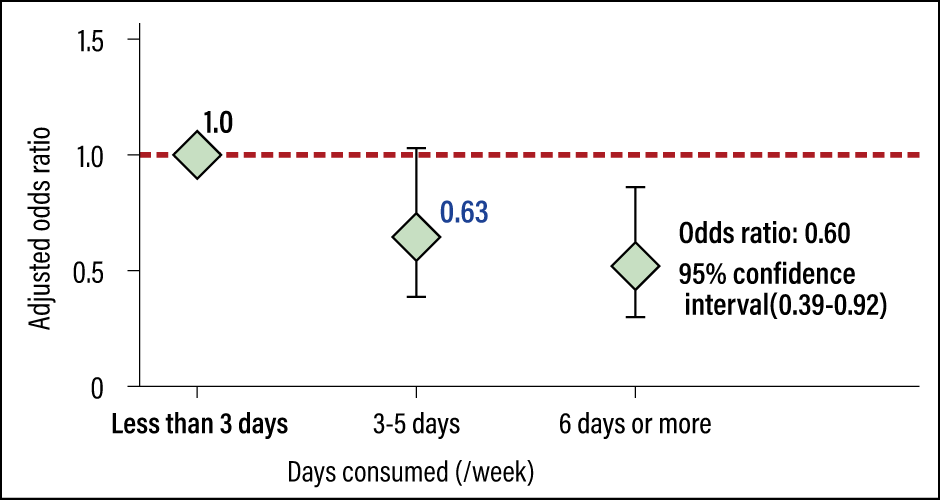 J Nutr,141(10):1862–1870, 2011.
J Nutr,141(10):1862–1870, 2011.
Figure 1. Habitual green tea consumption and influenza incidenceA questionnaire conducted between November 2008 and February 2009 among elementary school students in Kikugawa City, Shizuoka Prefecture received 2,050 responses. A significant difference in incidence rate according to consumption emerged.
In addition to drinking tea, people in Shizuoka Prefecture have for some time recommended gargling with green tea. However, just as with the use of a tea nebulizer to reduce MRSA, there was no scientific evidence for this practice. Feeling the need to scientifically verify this as well, I conducted a study of influenza incidence rates in which residents of a nursing home gargled either with green tea catechins or with water alone (Figure 2). The 124 participants chose whether to gargle with catechins or with water alone, and then gargled three times per day for three months. The results showed that 5 (10%) of the 48 people in the group that gargled with water caught influenza, whereas 1 (1.3%) of the 76 people in the catechin group did so. This actually represents around an eightfold difference. However, one would surmise that the people who chose to gargle with catechins in this study might well be more health-conscious than the people who chose to gargle with water, and might also have been more assiduous in undertaking other preventive measures.
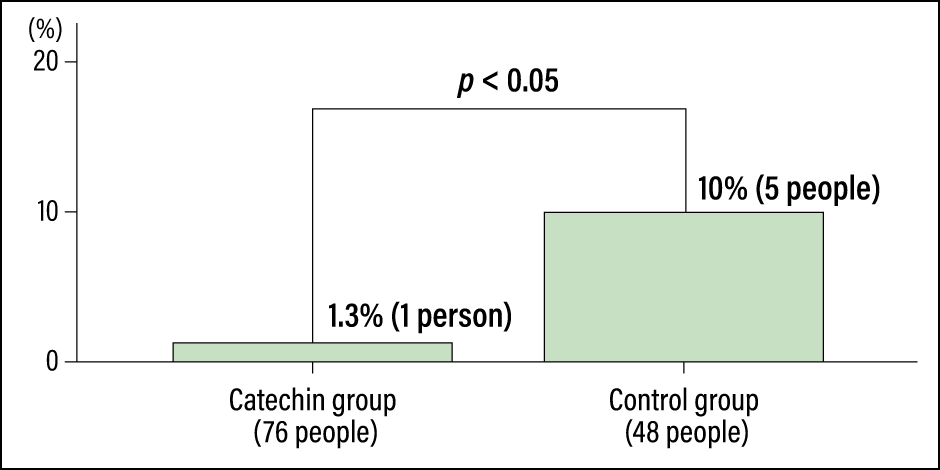 Yamada H, et al. J Altern Complement Med, 12: 669–672, 2006.
Yamada H, et al. J Altern Complement Med, 12: 669–672, 2006.
Figure 2. Effect of gargling with tea catechins on influenza prevention: comparison of incidence ratesDuring the influenza season in the winter of 2004-2005, 124 residents of a nursing home chose whether to join the catechin group (gargling with a catechin extract solution with a concentration of 200 µg/mL catechins) or the control group (gargling with water alone), and then gargled three times per day for three months. There was around an eightfold difference in the influenza incidence rate between the catechin group and the control group.
Accordingly, with the cooperation of Kakegawa Nishi High School in Shizuoka Prefecture, we conducted a clinical study among 308 students after gaining their consent and that of their parents/guardians. 155 gargled with green tea, while 153 did so with water. The participants gargled three times per day —— immediately after arriving at school, after the lunch break, and immediately before going home —— for 90 days. Among the 153 members of the water gargling group, the compliance rate was good (at least 75%), at 106, with 10 members of the group (9.4%) going on to develop influenza. Among the 155 members of the green tea gargling group, the compliance rate was also good, at 119, with 6 members of the group (5.0%) going on to develop influenza.
The next question is whether, in addition to drinking and gargling with green tea, taking a supplement containing catechins is also effective. In order to verify this, we produced a supplement on a trial basis. An amino acid called theanine —— an umami component in which green tea is rich —— has been reported to have such effects as boosting immunity, enhancing the quality of sleep, and alleviating short-term stress. We created a supplement that was quite high in theanine, containing 378 mg of catechins (equivalent to 2-3 cups of green tea) and 210 mg of theanine (equivalent to 10 cups of green tea), and had 200 adult healthcare workers take it for five months. The results showed a significant decrease in the influenza incidence rate among the group that took the supplement, at 4.1%, compared with 13.1% among the group that took the placebo (a capsule containing no catechins or theanine). However, there have been reports of liver dysfunction following the sale of catechin supplements in Germany. This suggests that caution regarding the catechin content is required when commercializing such supplements.
Why is green tea effective in preventing influenza? Before touching upon the mechanism, allow me to explain a little about the influenza virus.
Catechins inhibit the influenza virus
There are three types of influenza virus: types A, B, and C (some of which are referred to as type D). Two of these, influenza A and B, cause epidemics in humans. Both are spherical in shape, and covered with a lipid membrane called an envelope. In the center, or core, eight segments of ribonucleic acid (RNA) are bound to nuclear proteins and RNA polymerase, forming complexes called viral ribonucleoproteins (vRNPs). Projecting from the surface of the virus in the form of spikes are two glycoproteins: hemagglutinin (HA) and neuraminidase (NA). HA binds to a receptor called sialic acid on host cell surface membranes. NA activates an enzyme called sialidase that destroys sialic acid; it also plays a part in the viral budding and release processes described below.
Once the influenza virus is adsorbed to the mucous membranes of the nose and throat, the sialic acid and HA bind together, allowing the virus to penetrate the cell. The viral membrane fuses with the endosomal membrane in the cell, destroying the viral shell (a process called uncoating), and the genetic information from the core enters the cell. Transcription and replication of the viral genome then takes place using RNA polymerase, and viral particles are formed again. NA comes into play here, activating sialidase to detach the particles from the sialic acid, and the new viral particle is released after forming a bud on the surface of the host cell surface membrane. The newly released virus goes on to cling to another cell. The infection spreads through the repetition of this process.
There are four main catechins in green tea: epicatechin, epigallocatechin, epicatechin gallate, and epigallocatechin gallate. Epigallocatechin gallate accounts for as much as half of these, followed in descending order by epigallocatechin, epicatechin gallate, and epicatechin. Of these four catechins, epigallocatechin gallate and epicatechin gallate have been confirmed to be effective in inhibiting infection with the influenza virus.
These two catechins suppress the activity of the influenza virus via three mechanisms (Figure 3).
 Modified from Tominaga, T., Furushima, D., Yamada, H., Shoku to Iryō [Food and Medical Care], 16: 14–20, 2021
Modified from Tominaga, T., Furushima, D., Yamada, H., Shoku to Iryō [Food and Medical Care], 16: 14–20, 2021
Figure 3. Inhibitory effects of green tea catechines on influenza virus infectionCatechins inhibit three mechanisms used by the influenza virus, namely (1) adsorption to human cells, (2) uncoating, followed by transcription and replication of genetic information in the core, and (3) budding and release from the host cell membrane surface.
The first is the inhibition of adsorption. Catechins inhibit the binding of the influenza virus’s HA to the sialic acid on the host cell surface membrane. Gargling with green tea is thought to be effective in preventing influenza because it prevents this adsorption process. Black tea contains a polyphenol called theaflavin, which is a dimeric catechin generated in the oxidative process, and this, too, hinders the adsorption of the influenza virus. Another effect of catechins is to inhibit the uncoating, transcription, and replication of the influenza virus once inside the cell. In other words, they prevent new viral particles from being formed within the cell. Finally, catechins have been reported to inhibit budding and release facilitated by NA. Inhibition of budding and release is of great importance in suppressing infection; indeed, the main target of anti-influenza drugs such as Tamiflu is the inhibition of the budding and release process facilitated by NA. One could say that catechins have a similar effect to Tamiflu.
Green tea also contains a non-catechin polyphenol called strictinin. Strictinin is a tannin that originally came to prominence in reports that it had antiallergic properties, but it has also been discovered to be effective in inhibiting the proliferation of the influenza virus. Unlike catechins, it is thought to suppress infection by inhibiting the fusion of the viral and endosomal membranes. However, as green tea does not contain very much strictinin, I believe it is unrealistic to focus on this alone in investigating its preventive effects.
The expanding horizons of green tea catechins research
Emerging research findings indicate that green tea catechins are effective against not only influenza, but also other viruses and bacteria that cause acute upper respiratory tract infection. A variety of other effects have been reported, as well, beyond their antimicrobial and antiviral effects. First of all, there are effects on the prevention of lifestyle diseases. This includes demonstrating anti-arteriosclerotic properties, improving lipid abnormalities, reducing visceral fat, and inhibiting rises in blood glucose levels and blood pressure. Many other reports from basic research indicate the efficacy of green tea catechins in curbing dental caries (tooth decay), improving cognitive decline, anti-inflammatory and antiallergic properties, stimulating immune function, and antitumor properties —— that is to say, delaying the progression of cancer. The starting point for cancer research has been basic research indicating that green tea has antioxidant properties. Many epidemiological studies have indicated that people who habitually drink green tea over a long period such as five or 10 years are less prone to develop cancer in the future. However, it is unfeasible to actually carry out experiments to test the efficacy on humans. This is because, ethically speaking, one cannot deprive cancer patients of treatment in order to compare cancer progression in those who drink green tea and those who do not.
As experiments to test the efficacy of green tea against cancer are essentially impossible, we conducted a clinical study of the relationship between catechins and natural killer cells (NK cells), which attack cancer cells. A total of 20 Shizuoka City residents aged 65 years and over cooperated in the study by drinking a commercially available catechin-rich green tea beverage (total catechins: 540 mg per 350 mL) every day for two weeks. When we compared their NK activity, the mean activity had risen from 41.7% before intervention to 58.8% after the two-week intervention. However, in this clinical study, we did not verify activity among people who had not consumed the beverage, so this does not constitute strong evidence.
Many findings from basic research concerning links between green tea and cognitive function have also been published. There are even reports that green tea curbs the accumulation of amyloid-beta, a protein thought to be a contributory factor in dementia. Accordingly, we conducted a clinical study focused on improving cognitive decline, and verified that consuming green tea for three months curbs the decline in cognitive function. However, when it comes to declining cognitive function, simply suppressing it for such a short period is not enough. So, we conducted a study over the period of a year, but did not observe a great difference between those who drank green tea and those who did not.
These days, many people drink green tea packaged in plastic bottles that they buy in shops. Traditionally, however, people drank green tea brewed in a teapot. The person drinking the tea should probably be able to choose the temperature of the hot water poured onto the tea leaves. The hotter the water used to brew the tea, the higher its catechin and caffeine content, and the stronger its astringency and bitterness. Brewing tea with water cooled to around 50-60°C brings out theanine —— the component that gives green tea its umami —— and other amino acids in large quantities. This makes green tea tasty, and may promote sound sleep and reduce stress, but if you intend to drink green tea as a measure against infectious diseases, it would probably be advisable to use hotter water in order to bring out the catechins.
There are now even basic research reports emerging that indicate the effect of green tea catechins against the novel coronavirus responsible for the recent global pandemic. Accordingly, last winter I embarked on a new clinical study, investigating the effectiveness of gargling with green tea in preventing COVID-19 infection. Participants gargle with bottled green tea three times a day for 12 weeks. I believe that a total of 1,100 people will have participated by the end of March 2025. I look forward to seeing what results emerge in due course.







